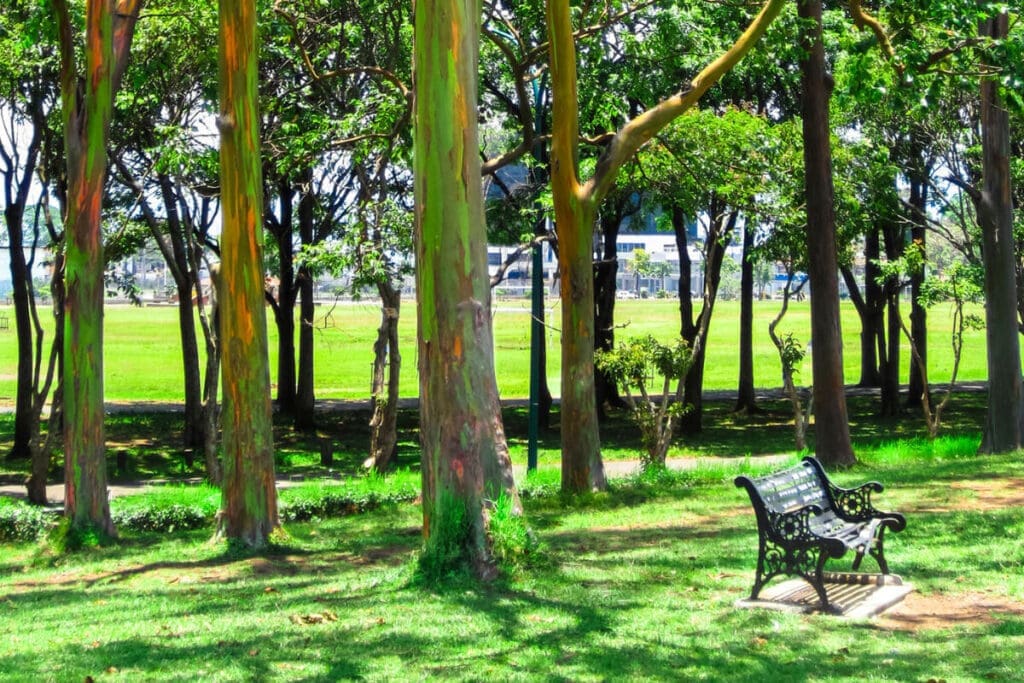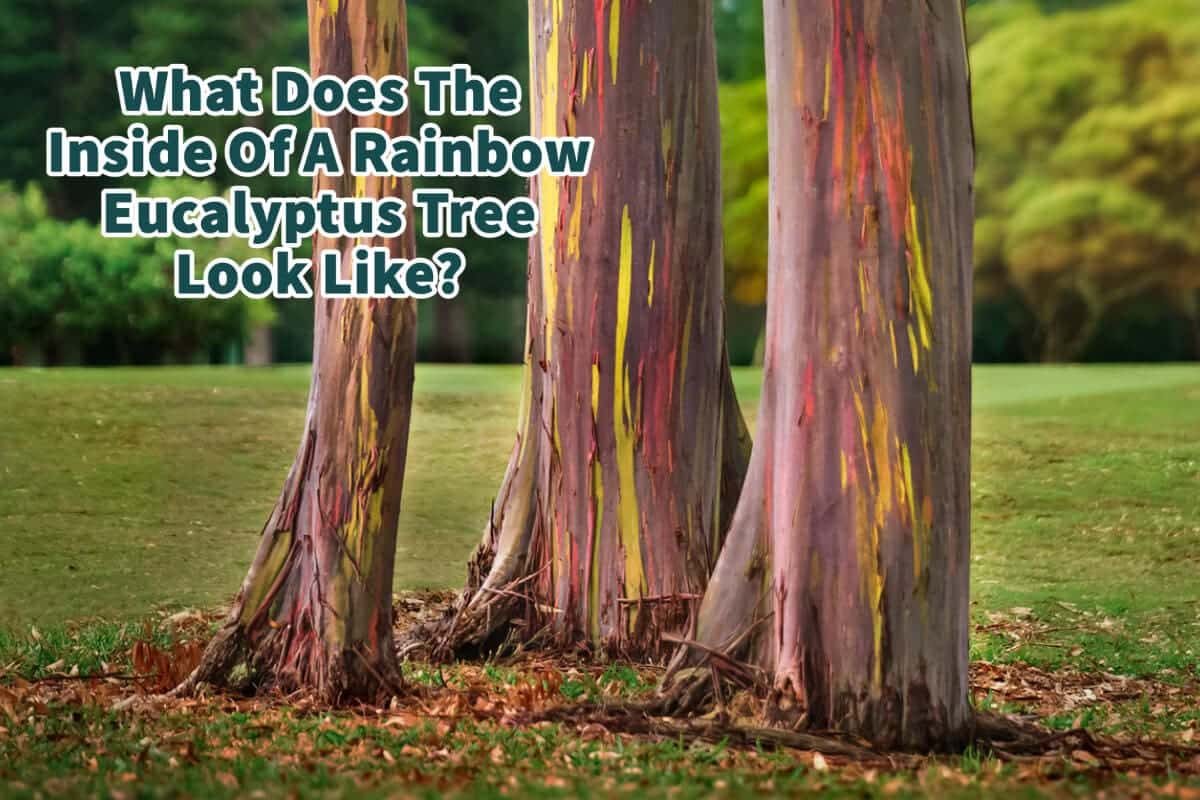One of the most amazing trees ever grown is the rainbow eucalyptus tree. The rainbow eucalyptus tree has a colorful appearance.
The rainbow eucalyptus tree’s wood is very similar to other eucalyptus woods. The rainbow effect of the tree is on the bark only and does not go inside the wood or inner part of the tree. The rainbow eucalyptus tree is native to Southeast Asia. Still, there are many places you can now see the trees in the United States, especially in Hawaii, Florida, and Southern California.
Table of Contents
- Inside The Rainbow Eucalyptus Tree
- 12 Facts About The Rainbow Eucalyptus Tree
- 3 Places To See A Rainbow Eucalyptus Tree In The United States
- Frequently Asked Question
- Related Content
Inside The Rainbow Eucalyptus Tree
The color of the rainbow eucalyptus tree comes from its bark. If you cut the tree down to use the wood, the wood will be about the same as any other eucalyptus type of wood.
The rainbow eucalyptus trees color comes from its bark color and not from the wood itself. The wood of the rainbow tree is a hardy tree with a close grain. As the wood of the rainbow eucalyptus tree is the same as other eucalyptus trees, there is no reason for most people to use the rainbow eucalyptus tree for any wood production.
The rainbow eucalyptus tree is not on the wood endangered species list, so it is growing on some tree plantations worldwide. In the Philippines, where there are many native rainbow eucalyptus trees, the trees grown on the plantations are usually grown for pulp to make paper products.
The Bark Of The Rainbow Eucalyptus Tree
The tree’s bark will produce various colors, which is why the tree is called the Rainbow Eucalyptus tree. The colors of the bark make the Rainbow Eucalyptus tree such a unique and beautiful tree.

When the tree bark is new, it will be bright green. As the tree matures, the bark will turn dark green, blue, purple, pink-orange, and red-brown. When the bark is peeled off at this stage, the bark will show a fresh, bright green color underneath.
Because the tree’s bark constantly changes color, it gives the tree a look and color that continually changes and adjusts its color.
12 Facts About The Rainbow Eucalyptus Tree
The rainbow eucalyptus tree is magnificent. Here are some facts about the tree and why it is such a particular tree.
- The real name of the rainbow eucalyptus tree is Eucalyptus deglupta. It gets the nickname rainbow eucalyptus because of the changing color of its bark.
- Other names for the rainbow eucalyptus tree include Mindanao gum and rainbow gum.
- The rainbow eucalyptus tree is an evergreen tree.
- The rainbow eucalyptus is native to the Philippines, Indonesia, and Papua New Guinea.
- The trees need consistent warm weather and a lot of rain to grow.
- Even though the rainbow eucalyptus tree is native to the Philippines, Indonesia, and Papua New Guinea, it has been widely planted in other parts of the world.
- Some rainbow eucalyptus trees have been seen in the United States, such as Hawaii, Southern California, Texas, and Florida. As the USA is not their native habitat, the trees planted in the United States usually only grow to about 100 to 125 feet, much less than the heights they will grow to in their native habitat.
- The rainbow eucalyptus tree usually thrives in rainforest areas.
- The rainbow eucalyptus tree is a fast-growing tree that can reach a height of 60-70 M (197 – 246 feet). The trunk of the rainbow eucalyptus can be 240 cm or 94 inches in diameter.
- The bark will come off the tree. As the bark comes off the tree, it reveals other colors under the old bark, such as green, red, orange, grey, and purple-brown.
- The rainbow eucalyptus tree has both some flowers and brown woody fruit.
- If you want to plant a rainbow eucalyptus tree, check your local restrictions, as the trees can be invasive.
3 Places To See A Rainbow Eucalyptus Tree In The United States
To see these trees in person is a magnificent experience. Even though the trees are not native to the United States, they have become popular in many parts of the United States.
Here are some places you may be able to see a rainbow eucalyptus tree:
- San Diego – You can see them at Balboa Park, along Sports Arena Boulevard, the San Diego Zoo, and parts of Mission Bay.
- Hawaii – Maui has a famous rainbow eucalyptus tree grove along the Hana Highway. You can also find them at the Ke’anae Arboretum. On Kauai, you can find them along the Princeville walking path. In Oahu, you can see them at the Wahiawa Botanical Gardens and Honolulu Zoo.
- Florida – In Florida, you can find the rainbow eucalyptus trees at the Port St. Lucie Botanical Gardens and Sunken Gardens in St. Petersburg. You can also see them at the Naples Botanical Gardens and Mounts Botanical Gardens in Palm Beach County.
The rainbow eucalyptus trees are magnificent to see in person.
Find out more about how Mondoro can help you create, develop, and manufacture excellent home decor and furniture products – don’t hesitate to contact me, Anita. Check out my email by clicking here or become a part of our community and join our newsletter by clicking here.
Mondoro gives out a FREE Lookbook to anyone interested. You can receive a copy of our latest Lookbook by clicking here.
Listen to our Podcast called Global Trade Gal. You can find it on all major podcast platforms. Try out listening to one of our podcasts by clicking here.
Subscribe to our Mondoro Company Limited YouTube Channel with great videos and information by clicking here.
Frequently Asked Question
What is the rainbow eucalyptus tree?
The rainbow eucalyptus tree, also known as Eucalyptus deglupta, is a unique and colorful tree known for its vibrant, multicolored bark.
What causes the rainbow effect on the bark of the tree?
The rainbow effect on the bark of the tree is caused by patches of outer bark shedding at different times throughout the year, revealing bright green inner bark that changes color over time to blue, purple, orange, and maroon.
Does the rainbow effect extend into the wood of the tree?
No, the rainbow effect is limited to the bark of the rainbow eucalyptus tree and does not penetrate into the inner wood or other parts of the tree.
How is the wood of the rainbow eucalyptus tree different from other eucalyptus woods?
The wood of the rainbow eucalyptus tree is similar to other eucalyptus woods in terms of its properties and uses. However, its unique and striking appearance makes it popular for decorative purposes.
Where is the rainbow eucalyptus tree native to?
The rainbow eucalyptus tree is native to Southeast Asia, particularly the Philippines, Indonesia, and Papua New Guinea.
Can the rainbow eucalyptus tree be found outside of Southeast Asia?
Yes, the rainbow eucalyptus tree has been cultivated in various regions around the world, including the United States.
Where can you find rainbow eucalyptus trees in the United States?
Rainbow eucalyptus trees can be found in several places in the United States, with notable concentrations in Hawaii, Florida, and Southern California.
Can rainbow eucalyptus trees survive in different climates?
Rainbow eucalyptus trees thrive in tropical and subtropical climates, where temperatures remain consistently warm throughout the year.
Related Content
Is Teak a Coniferous, Evergreen, or Deciduous Tree? 11 Teak Wood Facts
Teak is a deciduous, not evergreen or coniferous tree. Teak leaves do not fall off in the wintertime, but in the dry season; in Asia, where teak trees are naturally grown, the dry season is not always the same as winter. As the teak leaves do fall off, the tree is considered to be a deciduous tree.
You can discover more by reading Is Teak a Coniferous, Evergreen, or Deciduous Tree? 11 Teak Wood Facts by clicking here.
What Are The Types Of Wood Used In Furniture?
Wood for furniture is divided up into hard and softwood. Though the woods have some similarities, they also have some differences. Different looks and types of furniture may require a certain kind of wood. Some wood species will be higher priced, and others will be cheaper; price, durability, look, color, finish, and structure can decide what wood to choose for your furniture piece.
You can read our blog on What Are The Types Of Wood Used In Furniture? by clicking here.
Rattan Furniture And Asia and Southeast Asian Colonization
When colonizers came to the new countries, they found materials they were not used to working with, such as rattan, palm, and bamboo. They used this to create something that can comfort their home, such as chairs to sit on. Many of the places they colonized did not traditionally have chairs for sitting.
You can learn more by reading our blog, Rattan Furniture And Asia and Southeast Asian Colonization, by clicking here.

